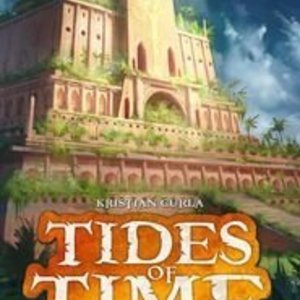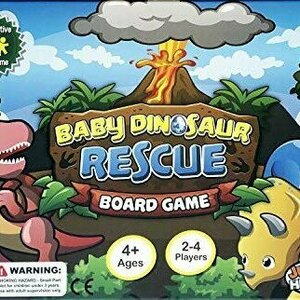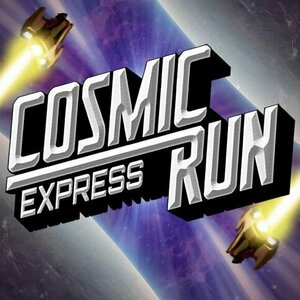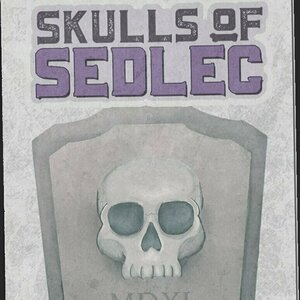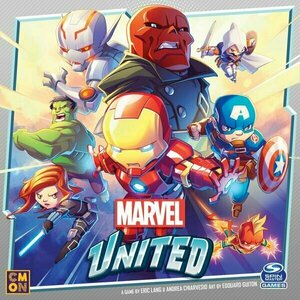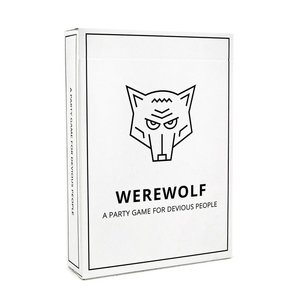
Werewolf: A Party Game for Devious People
Tabletop Game Watch
The Village is your mission: You will attempt to save it or destroy it. One minute you're a...
Purple Phoenix Games (2266 KP) rated Tides of Time in Tabletop Games
Oct 17, 2019
Tides of Time is a card drafting and set collection mini civilization building game that spans three ages (rounds). The player with the most amount of VPs at the end of the game is the winner. The VPs are scored at the end of each round and then added to arrive at the final score. You earn VPs throughout the game by having cards in your civ that feed off each other in amazing combo play.
To setup, shuffle the big civ element cards and deal each player a hand of five. Place the others nearby to draw from during the subsequent rounds. Place the “Relic of the Past” tokens nearby as well. You are ready to play.
On your turn you will draft one card from your hand, then pass to your opponent. When you select a card, play it to your tableau in front of you. Continue this simple draft until you have your Round 1 civilization cards ready to score. Each card will belong to one of five suits, with three card being unsuited, and each card having some sort of scoring ability or special ability to affect the cards in play. Example: having a majority in crown suit cards will score you 7 VP (the top leftmost card in the play pic below). Obviously if you have played this card early in the round you want to try to amass the majority of crowns for those yummy 7 VPs. This is how the card combos will generally work, with many other rules and scoring abilities to discover on your own.
At the end of Round 1 and 2 you will select one of your cards you played this round and place the “Relic of the Past” token on it. This freezes the card to your tableau to be used again in future rounds. So taking our example from before, if you chose the 7 VPs from crown majority card in Round 1, you can use it in Rounds 2 and 3 to score again should you satisfy the scoring ability. 21 VPs from one card is pretty great.
Components. This is a bunch of cards, two cardboard tokens, a score pad, and a golf pencil. The cards are great quality, and a satisfyingly large size. The tokens are good as well, and the writing supplies are good too. The artwork throughout is very very good and I enjoy studying the paintings, though they have nothing to do with game play. No complaints here at all.
I am a sucker for drafting games where you pass your hand to gain other card. Games like 7 Wonders, Among the Stars, and even Sushi Go! are really good times. When I play Tides of Time it gives me that same feeling of trying to guess your opponent’s strategy as well as fulfill your best tactics to score massive points. It is quick and light and a really great filler. There is enough variability in this one to keep me coming back for more and I definitely enjoy pulling it out giving it a run.
My only concern is that I don’t pull it off the shelf enough. It is in a weird slot of 2-player filler. When I feel like playing a great 2-player game, I will typically pull out Patchwork, 7 Wonders: Duel, or Jaipur. This really is a great game, and if you are a fan of drafting games that have you exchanging hands (as opposed to simply drafting from a face-up row or grid) then you should give this one a try. I do enjoy other games a bit more, but I am glad we have this available to us. We at Purple Phoenix Games give this one a pasted-on 8 / 12.
Purple Phoenix Games (2266 KP) rated Baby Dinosaur Rescue in Tabletop Games
Apr 21, 2021
The island’s volcano is about to erupt! We HAVE to get these baby dinosaurs to safety FAST! Place the game board on the table with the lava tracker token on the highest lava spot. Depending on how challenging you want your game, place all your dinosaur tokens at the bottom of the board ready to move to safety. Shuffle the cards and deal each player three. You are ready to truck it to the safety of a neighboring island.
On your turn you will play a card from your hand and move any dinosaur to the next-closest open spot that matches the card you played. So if you play that Fish Bone card, move one dino to the first Fish Bone spot on the board you see. Draw another card and it’s the next player’s turn. Do they also have a Fish Bone? Great, play it now because the next-closest open Fish Bone spot is the one PAST where you last placed a dino moving them even further ahead!
Uh oh, have a Lava card in your hand? You HAVE to play that first. When a Lava card is played, no dinosaurs move, but the Lava token moves down one spot closer to obliterating the island!
Play continues in this fashion of playing cards and hopefully leap-frogging dinos to move further ahead on the path to safety. Players are playing cooperatively, so either everyone wins when all the dinos get to the other island, or everyone loses because the island has been burninated.
Components. Any game with a trumpet-playing character already has great components. But, the board and chips are good sturdy quality, and the cards are as well. If you find that you will be playing this one quite a bit I would suggest sleeving the cards as they are handled a lot during play.
We love this game and my son requests it more than any other game we own. It is simple, fun, and tense at times! What we love about this game as parents is that it teaches children about cooperative gaming. No dinosaurs are owned in the game – everyone is trying to save ALL the dinos, not just “THEIR” dino. It also teaches that sometimes you have Lava cards and are unable to help the team, and that’s okay because another player will pick up that slack and make the team better. Gotta love educational games with great themes! Pick it up online as I haven’t seen it in stores anywhere.
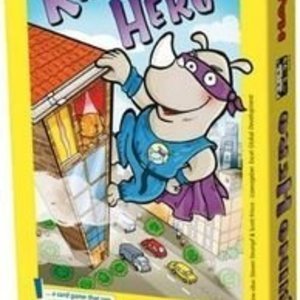
Rhino Hero
Tabletop Game
Super Rhino! presents players with an incredibly heroic – and regrettably heavy – rhinoceros who...
Purple Phoenix Games (2266 KP) rated Cosmic Run: Express in Tabletop Games
Oct 27, 2021
The latest game in Dr. Finn’s Cosmic Run universe, Cosmic Run: Express pits two players against each other, racing to be the first to reach 3 new planets. It is a game of area influence and simultaneous action selection played over a series of rounds in which players are playing cards to the 3 planets to advance their movement trackers the necessary 12 points to reach the planets. To setup the game, place the 3 planet cards in numerical order between the two players. Each player takes a set of 3 movement trackers in their chosen color and places one on their side of each planet card. All of the movement trackers are set to 0 for the start of the game. Players are dealt 6 ship cards, and the game is ready to play!
To begin a round, players look at their hand of 6 cards and choose 2 to pass to their opponent. Taking the new cards into your hand, you can decide to discard 1 card and draw a new card. This is not required, but can be performed by each player in each round. Next, players will simultaneously choose a card from their hand to be played face-up next to any planet, beneath their corresponding movement tracker. You can only play a maximum of 2 cards per planet.. If the color of the card you play at a planet matches the color at the top of your movement tracker, you may immediately move your tracker up by 1. Play continues, simultaneously playing cards, until all 6 cards in hand have been played and each movement tracker has 2 cards next to it.
Now we move to the scoring/movement phase. Starting with Planet 1, compare the 2-card hands and determine which player played the best hand. The hierarchy for determining best hand is described in the rules, and that player earns 2 movement points for that planet, and adjusts their tracker accordingly. After scoring best hand, players score arrows. Underneath the number on each card is an arrow pointing either left or right, with a corresponding color. Beginning with the player who did not win best hand, look at the arrows on their 2-card hand, and score movement points if the arrows match any cards in their adjacent planets. Repeat these scoring steps for Planets 2 and 3. If, by the end of scoring, a player has earned 12 movement points and reached all 3 planets, that player is the winner! If not all 3 planets have been reached, collect all the cards, shuffle them, deal 6 to each player, and begin a new round. Rounds continue until one player has reached all 3 planets.
As a fan of the Cosmic Run universe, I was excited when I saw Cosmic Run: Express on Kickstarter. It seemed light, simple, and in the same universe as other games I loved, so I decided to back it. How does it fare? I think it’s great! For starters, I really appreciate that it is a small, portable game that can be played virtually anywhere. Lots of games these days are real table-hogs, and I enjoy the minimalistic approach of this game. Getting into the gameplay – it requires way more strategy than you initially think. There are 3 different ways in which you can score movement points (color matching, best hand, and arrow scoring) and you need to utilize all 3 for success. You are constantly evaluating your hand of cards and trying to determine which placements will yield the most points for you. Maybe you don’t have a color match, but the arrow on that card could make up for that and earn you up to 2 movement points. Another neat strategic point is that you have to pay attention to your opponent as well. The best hand points are a direct head-to-head between players, so not only do you have to maximize your own strategic points with card placement, you have to watch your opponent’s card placements and see if you can get a better hand than they do for a given planet. You are constantly engaged in this game, and that’s what I love about it.
Another great thing about Cosmic Run: Express is that it plays so quickly and effortlessly. Yes, at first there’s a tiny bit of a learning curve to remember the hierarchy for best hand, but after a couple of rounds the game flow is streamlined. It only takes 10-15 minutes to play, so it is easy to play “just one more” when you’re done. It’s light and fast enough to be a great filler between games, but it is also strategic enough to hold its own in a full game night.
So overall, how do we feel about this game? For being a nice and small 2-player game, it packs quite a punch! I was very pleasantly surprised by the amount of engagement and strategy in this game, and it is definitely one that I want to play multiple times in a row. So mission accomplished, Dr. Finn – in this case, less IS more. It’s a great little card game, and I highly recommend giving it a shot if you’re looking for something small but mighty. Purple Phoenix games gives Cosmic Run: Express a stellar 9 / 12.
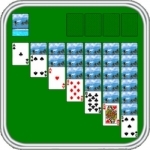
Solitaire (Klondike)
Games and Entertainment
App
Klondike is a solitaire card game. Many people refer to Klondike as "solitaire". aking a standard...
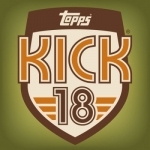
KICK: Football Card Trader
Sports and Games
App
Topps® KICK® 2018: Football Card Trader is the official digital card trading app of the Premier...

YOHO (You Only Hang Once)
Tabletop Game
YOHO (You Only hang Once) is a non-cooperative card game where each player takes on the role of a...
Purple Phoenix Games (2266 KP) rated Skulls of Sedlec in Tabletop Games
Feb 27, 2020
Let us travel back to the 16th Century AD. You are a monk working in the Sedlec Ossuary, a chapel in the Czech Republic. The coincidental timing of the Black Plague and the Hussite Wars has led to some serious overcrowding in the Sedlec graveyard. Working under a half-blind monk, you and your fellow underlings have been tasked with exhuming graves and artfully arranging the skulls in the crypt. Who can create the most unique and tasteful display of skulls? There’s only one way to find out.
Disclaimer: We were provided a prototype review copy of this game for the purposes of this preview. The final components may vary once the Kickstarter campaign has concluded, so the published game may look differently than the one presented in these pictures. -L
Skulls of Sedlec is a game of card drafting and hand management in which players are trying to amass the most points by the end of the game. Here’s how it works. To set up, shuffle all 18 cards. Create a 2×3 grid of 6 facedown piles consisting of 3 cards each. Pick any pile and flip one card face-up from the top. You are now ready to begin! The game is played over a series of turns in which players will draft and play cards into their personal Stack, an arrangement of cards in a pyramid shape. Each card has 2 skulls on it, and each skull earns a certain number of points based on its placement in your Stack. For example, Criminal skulls are vying for redemption in the afterlife, so they score 2 points if they are adjacent to any Priest skulls. At the end of the game, the player with the highest scoring Stack is the winner!
During the game, on your turn, you will take one of these three possible actions: Dig, Collect, or Stack. When you choose to Dig, you choose 2 facedown piles in the graveyard and flip their top cards face-up. Once you have done that, choose one of the two cards you flipped to take into your hand. If you choose to Collect, you simply choose any face-up card from the graveyard and take it into your hand. There is a hand limit of 2 cards per player, though, so if you already have 2 cards in your hand you may not take the Collect action. If you choose to Stack, you select one card from your hand and add it to your Stack, following the placement rules – Stacks are built from the bottom up. Your first card will be placed into the bottom row of your Stack. Depending on how many players are in the game, your Stack will require a different number of cards in each row. A card may only be played into a higher row if it is directly centered over two cards on the row beneath it. Logical enough! The game ends when each player has completed their Stack. Points are then added, and the highest score wins.
As I mentioned earlier, the size of the game does not always dictate the quality of the game, and Skulls of Sedlec is the perfect example of that. For only consisting of 18 cards, it takes a good deal of strategy to claim victory. There are 5 different types of skulls, and they earn points in different ways depending on their placement. You really have to be thinking in advance as to how you want to play the cards in your hand, and what other skulls you need to pick up to maximize your score. You can also see the Stacks of your opponents, so you know what you’re up against. You need an adaptive strategy for success based on the current cards available in the graveyard, as well as potentially anticipating your opponents’ moves. Be careful, though, because once a card has been played to your Stack, it cannot be moved.
Components. Again, this is just a preview copy of the game, but the card quality is already great. It might be something upgraded during the Kickstarter campaign, but if it’s not, you’re still getting a high quality game. Of course, the trademark wallet is on par with the rest of the wallet series, and it protects the cards well. The artwork of Skulls of Sedlec might not be awe-inspiring, but it is still colorful, thematic, and well-done. I appreciate the simplicity of the cards because it makes it easier to see the card types throughout the game and final scoring. You can clearly tell which skulls are which, so the game does not grind to a halt while trying to figure out what the scoring requirements are for a particular skull. And each skull type has a corresponding symbol, which can help our color-blind friends play the game – instead of relying solely on color, the symbols help differentiate the cards. So big kudos there!
As someone who does a fair amount of solo playing, I would like to mention the solo expansion of Skulls of Sedlec, Monstrance. Again, this is a preview of the solo expansion, so final rules and components may vary from those described here. When playing Skulls of Sedlec as a solo game, you will be creating a Stack like in a multiplayer game, as well as a Feature. The Feature you build will have a shape different to that of your normal Stack, and is determined by the Feature card you select at game setup. You will also select a second Feature card, which will be flipped over to reveal a new condition or effect for the game (for example, Romantics in the Stack do not score). Create a graveyard of 4 facedown piles of cards, evenly spread throughout the piles. You are then ready to play.
Gameplay is similar to that of a multiplayer game, but the solo player does not have a hand of cards. Instead, every card that you select will be immediately played into your Stack or your Feature. Placement rules are the same for the Stack, and cards in your Feature must be supported from below or adjacently. When both your Stack and Feature are complete, the game is over and you tally up your score. The solo expansion offers scoring milestones to compare with your score. See if you can best yourself and become a Legendary Artisan instead of remaining a Humble Monk.
Personally, I am not a huge fan of beat-your-own-score solo expansions. That being said, the gameplay of the Monstrance solo expansion still requires decent strategy and thought to maximize your final score. The addition of Features to solo play add another level of strategy because placement is just as important there as it is in your general Stack. Another neat twist is the addition of effects/conditions in solo play. They affect your strategy and make for a unique game every play.
Overall, I would say that Skulls of Sedlec is one of my favorite ButtonShy Games that I have played. It’s fast to play, simple to teach and learn, yet strategic enough that it keeps you engaged the entire time. Another thing I love about it is that it is only a 2-3 player game. We all know that getting together for game nights can be tricky, so I can see myself bringing Skulls of Sedlec to many game nights in which maybe only a few of us could attend. I’m glad I got the opportunity to preview this game, and I will be following the progress of the campaign for sure. If you’re looking for a small filler that still keeps your brain working, definitely consider backing the Skulls of Sedlec campaign!
Purple Phoenix Games (2266 KP) rated Marvel United in Tabletop Games
Sep 1, 2021
Disclaimer: This review encompasses only the base game of Marvel United. There are a number of expansions, but they will not be addressed in this review. -L
Marvel United is a cooperative game in which players take on the roles of various Marvel superheroes tasked with stopping the main Villain from completing their Villainous Plot. Follow the setup instructions detailed in the rulebook, selecting a Villain with whom to battle, 6 random Locations, and whichever Heroes you decide to use to fight the big bad. Place Threat cards, Civilians, and Thugs on the various Locations as indicated, and place the Villain and Heroes as described in the rules. Shuffle the Master Plan deck and respective Hero decks, and each player draws a hand of 3 cards. Choose a Hero as the ‘starting’ Hero, and the game is now ready to begin!
Over a series of turns, players will be resolving Villain effects and playing Hero cards to perform actions. The game always begins with a Villain turn, and the first step is to reveal a Master Plan card, adding it to the Storyline (table). Master Plan cards have different effects to be resolved – move the Villain to a new Location, BAM! effects (usually attacking Heroes or advancing their Villainous Plot towards victory), and adding Civilians/Thugs to surrounding Locations. Once all effects on the Master Plan card are dealt with, the game moves to a Hero turn. During a Hero turn, the player will perform 4 steps: Draw a card, Play a Card, Resolve Actions, and Location Effects. To start, the player will draw a card from their Hero deck and add it to their hand. They then select a card from their hand to play, adding it to the end of the Storyline.
Looking at the symbols at the bottom of their played card, the Hero will now resolve their actions. Actions could be Movement (to an adjacent Location), Attack (Thugs/Henchmen or the Villain in their current Location), Heroic Actions (rescuing Civilians or working to clear the Threat on their current Location), or Wild (any of the previous actions). During this step, a cool twist comes into play – after all, the game is called Marvel United, right? When a Hero plays a card, they resolve the symbols on the bottom of their card AND the symbols on the bottom of the previously played Hero card! This simulates the various Heroes uniting their efforts to take down the Villain! So when selecting your card, be sure to check out the last card to see if you can create a sweet chain of actions for maximum benefit. The final step is to use Location effects, if applicable. Location effects are only available after the Threat to the Location has been cleared, and allows the player to perform special actions (draw extra cards, move to other Locations, etc.). If you end your turn on a Location that has been cleared, you may use its ability if you so choose.
In order to defeat the Villain, the Heroes must complete Missions. The 3 Missions in each game are to Rescue Civilians, Defeat Thugs, and Clear Threats. So with their actions on their turns, Heroes will be working to complete these Missions, moving them closer to victory. The turn sequence of the game is unique as well – the Villain will take a turn after every 3rd Hero turn, not opposite every single Hero. Keep that in mind as you decide which card to play when! The game essentially continues in this fashion (with a few extra effects) until either the Heroes win or they lose. Heroes win if they defeat the Villain! The Villain is defeated when at least 2 Missions are completed, and the Villain has been sufficiently damaged by Attacks. Heroes lose if the Villain completes their Villainous Plot, the deck of Master Plan cards has run out, or if any Hero starts their turn with no cards left to play. The Heroes either win together or lose together.
So I know that kind of sounds like a lot, but I promise that once you get playing, the game flows really well and is pretty intuitive. Marvel United can basically be broken down into 2 steps: Villain turn and Hero turn. All you are doing is playing cards and resolving actions to complete your goals. One of the coolest things about this gameplay is the fact that on your turn you resolve not only your played card, but also the previously played Hero card as well. It does a good job emulating the Heroes working together, and adds a strategic element to the overall gameplay. Maybe you wanted to play a certain card, but based on the last Hero card, you should play this one to benefit the group the most. Players really are all working together to defeat the Villain, instead of each playing their own Hero and going in for the fight one-on-one.
Another neat aspect of the game is the inclusion of the Missions. Heroes are not allowed to directly attack the Villain until at least 2 Missions have been completed. This ups the gameplay because it stops players from just going straight for the Villain from the start, not taking anything else into account. In ‘real life,’ Heroes are also concerned with saving Civilians and neutralizing threats, so the Mission requirement makes the gameplay feel more authentic. Well, as authentic as a superhero game can feel…. The variability of Locations and the random setup of Threats each game means that you likely won’t play the same game twice. Add in expansions too and you’ve got even more scenarios. With different Hero choices, you get to try out different combinations and find out which Heroes really work well together. The gameplay itself may be simple (draw cards, play cards, resolve cards) but the variety of Heroes, Villains, Locations, Threats, etc. keeps it engaging and entertaining.
As for components, I only have positive things to say. The Villain/Hero minis are chunky and cute, the artwork is all colorful and fun to look at, and the cardboard tokens are thick and crisp. All the symbolism in the game is clear, and the text is legible and easy to comprehend. One thing to consider is that this game can be a bit of a table hog if you let it. So just be prepared for a bit of a bigger footprint with this one. Overall, great production quality of the base game, and from what I’ve seen of the expansions, those are top notch as well.
Don’t let the cutesy artwork fool you – Marvel United isn’t an easy game by any means. It takes a decent amount of strategy to be successful, and it does really take a team effort. You stay engaged in the gameplay right up until the very end, and it’s more involved than you would think for being a lighter game. I am also a big fan of Marvel Legendary, and I have to say that this gives me those vibes, but in a more simplified and streamlined way. I’m not sure I would go as far as to call Marvel United “Marvel Legendary Jr.,” but it’s also not entirely a bad idea….. Overall though, I really liked Marvel United way more than I first anticipated. It’s light, yet strategic, and has some unique elements that keep you on your toes. I can’t wait to get my hands on some of the expansions to see how I can mix and match and create even more awesome scenarios! Purple Phoenix Games gives this one a heroic 16 / 18.
